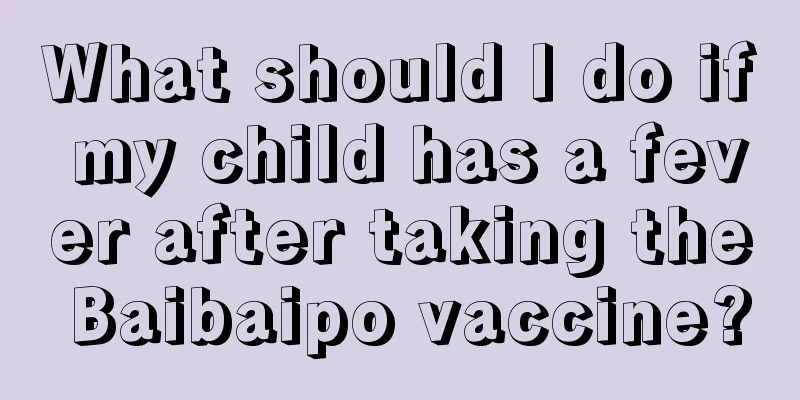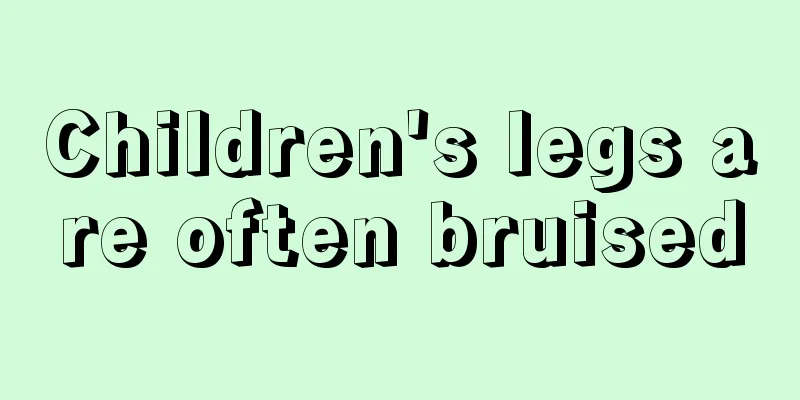What should I do if my child has a fever after taking the Baibaipo vaccine?

|
Many children will have a fever after receiving the DPT vaccine. Parents must be extremely worried when encountering this situation, fearing that the children will have adverse reactions and that it will affect the children's physical health. Faced with this situation, people need to pay attention and take timely measures to deal with it. Here is what to do if your child has a fever after getting the DTP vaccine? Many babies will have a fever 1 to 2 days after receiving the DTP vaccine, but it is usually below 38°C and does not exceed 38.5°C. At this time, we just need to let the baby drink more water to promote the excretion of metabolic products in the body to facilitate lowering the body temperature. Generally, no special treatment is required. However, if the body temperature exceeds 38.5℃ and the high fever persists, or is accompanied by other discomforts, we should go to the hospital for treatment. What should I do if my baby has a fever after receiving the DPT vaccine? 1. Drink plenty of water After receiving the diphtheria, pertussis and tetanus vaccine, the baby should drink plenty of water and eat liquid food, such as watermelon juice, to ensure that the body has sufficient energy and water, so that the fever can be reduced in time. 2. More ventilation and heat dissipation After the baby receives the DTP vaccine, parents should pay attention to ventilating the room, dissipating heat, wearing loose clothes, and avoiding wrapping the baby with a quilt. You can use air conditioning in the summer and control the room temperature at around 27℃. Remember to open windows regularly to allow air convection in the room. 3. Take rest If your baby shows signs of fever after receiving the diphtheria, pertussis and tetanus vaccine, you should get more sleep. Ensuring adequate sleep can help with recovery from the illness. Antipyretics, such as Tylenol and Anesthesia drops, should only be used after the body temperature reaches 39 degrees. However, when infants and young children under 3 years old have a high fever, physical cooling methods should be used first. Generally, antipyretic injections and antipyretic drugs are not required to avoid collapse and drug toxicity reactions. Other drugs should also be used with caution. 4. Physical cooling Warm water bath: Dip a towel in warm water (the water temperature should not be too hot to touch) and wipe the neck, armpits, and thighs for 5 to 10 minutes. You can also use a commercially available "cooling patch" (or a household ice pack) on the forehead to help dissipate heat and reduce temperature. What are the adverse reactions to the DTP vaccine? General reaction to DTP vaccination: mainly comes from the bacterial components contained in pertussis. 12-24 hours after vaccination with non-adsorbed vaccine, local redness, swelling, pain, and itching may occur. Some people may experience swollen lymph nodes in the armpit on the injected side after injection. When vaccines containing adsorbents are administered, nodules or sterile abscesses may form at the injection site. Rashes and angioedema are occasionally seen. The main systemic reaction is mild fever, which is more common after vaccination with non-adsorbed vaccines, but it will return to normal within 48 hours after vaccination. Fever may also be accompanied by short-term symptoms such as fatigue, drowsiness, and irritability. Abnormal reactions after DTP vaccination: are also mainly related to the pertussis component in the vaccine. In rare cases, allergic reactions or neurological complications such as convulsions, twitching, and screaming may occur. However, the incidence of such abnormal reactions is extremely low and does not affect the implementation of the immunization policy. |
<<: What should a one and a half year old baby eat if he is anemic?
>>: Why are baby's eyes purple?
Recommend
What to do if your newborn baby has a blocked nose
The breathing of a newborn is a particularly impo...
What should I do if my child’s eyes are bloodshot after being hit by a hard object?
Children's skin is relatively delicate and th...
What is the importance of parent-child communication?
Nowadays, more and more people pay attention to c...
How can children improve their allergic constitution?
In daily life, I believe that for many friends wi...
Why are baby's eyes purple?
The baby's physical condition is constantly c...
How to treat a baby’s runny nose and cough?
Babies have relatively low resistance, so if they...
What should I do if my 13-year-old child has loose teeth?
In fact, many reasons may cause children's te...
Causes of night coughing in children
Children’s immunity is relatively low, especially...
What to do if your two-year-old baby is constipated
There are many reasons why two-year-old babies su...
The child shakes his head and has a headache. What's going on?
With the vigorous opening up of the country's...
How to treat jaundice in children
Due to the mother's damp and cold constitutio...
What to do if children have severe picky eating
Everyone has different tastes in food. Everyone h...
What should I do if my child is frightened and has a fever?
Some children will have a fever after being frigh...
Child coughing and vomiting
Some children often experience nausea and vomitin...
Causes of rickets in children
There are many common diseases among children. Wh...









